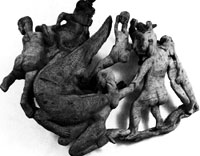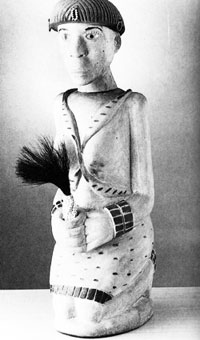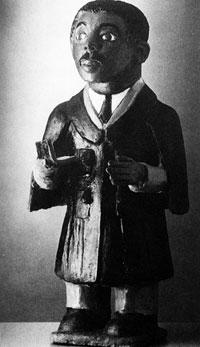During the 1980s the work of a number of sculptors working in the northern part of the country, Gazankulu and Venda, came to the attention of academic researchers and galleries. This work, given its first major public viewing on the Tributaries exhibition (1) caused a significant stir, bringing what appeared to be a completely autonomous aesthetic, an art that was in no way mediated by the forces of the white market or white teachers. Ivor Powell reviewÂing the Tributaries exhibition commented:
Much more important, though, was the realisation that there is an indigenous independent and vital art in South Africa and that it has been flourishing for years, unÂheeded by and regardless of the machinations of the art world in general. (2)
Powell saw this as refreshingly different given the overÂriding mediation of the 'art world' in the creation of the 'township' style. However he and many of the other critics who heralded this 'refreshingly new and untainted' art were dismayed at the manner in which it was instantly commercialised and marketed. Colin Richards referred to it as " a take-away African Spirit for the culturally needy". (3) 'TakeÂaway' to the extent that the marketing of art by black South Africans has become a lucrative business run through a variety of galleries, curio shops and street vendors.(4)
This art would have been designated 'naive art' or 'folk art' in any other society. Without doubt the work can be compared with folk traditions from other cultures in Africa as well as Eastern and Western Europe and the Americas.(5) The enormous difficulty involved in using such descriptive terms is discussed by Emile Maurice, who points to the implicit condescension that arises out of categories that set up hierarchies within the creative arena.(6)
 Xulu Ruben (1952 - 1985)
Xulu Ruben (1952 - 1985)
Nativity relief
The sculpture of the 1980s can be compared to an enormous variety of sculpture that has been produced by black artists during the past twenty or more years. This body of work can be broadly divided in three categories. The 'ecclesiastical art ', a sculptural tradition in carved wood, established through church patronage from the 1930s up to the 1970s involving artists such as Ernest Mancoba, Michael Zondi, Bernard Gcwensa and Ruben Xulu. This usually involved the depiction of overtly Christian themes, carved out of wooden blocks. This sculpture often reflects the fact that it has been carved out of a rectilinear block and usually involves fairly static forms. This is markedly different from the sculpture produced in Gazankulu and Venda which is mostly carved from unprocessed timber, including the roots of trees, resulting in dynamic movement and the inclusion of natural forms.
Both of these sculptural approaches can be compared to the 'fine art' sculptural tradition that arose out of the Polly Street era and work produced by Sydney Kumalo, Lucas Sithole, Ezrom Legae and many others. These artists generally worked in clay, which was then cast in bronze. Sithole has also worked in unprocessed wood. The manner in which Sithole's work is presented and the importance accorded to the resolution of the base indicates a consciousness on his part of a fine art context. This can be contrasted to the work of Jackson Hlungwane whose works were never conceived to be displayed in galleries. The bases made for his fish sculptures always appear to be an afterÂthought.
 Mabasa Noria (b.1938)
Mabasa Noria (b.1938)
Carnage II
The sculpture produced in Gazankulu and Venda has been referred to as 'transitional art' implying a transition from one cultural context into another, a cross fertilisation between western and African modes. However this phenomenon has been noted on many occasions in the history of the art of black South Africans. In what sense might this art be any more a transition or a synthesis of cultural forms?
The more frequently the word "transitional" is used to describe the work of some contemporary South African artists the more unsatisfactory it becomes...
Irma Stern included a funerary figure from Bakota in a painting, Walter Battiss arranged a number of identical carved birds from Swaziland across, a canvas... no one would dream of describing these as "transitional ".( 7)
An interesting dimension to these new developments in South African art is the debate generated amongst critics and scholars, particularly in the columns of the arts pages of The Weekly Mail. The very academics who used the term ' transitional 'proceeded to deconstruct the term, reject it and declare it unsuitable to the task of describing this new art. At the root of this search for an appropriate term there existed the need to come to grips with an approach to art that was distinctly different from any previously exhibited artÂwork. A distinction was drawn with the work of the ' fine ' artist; the artist who produced with the gallery and museum in mind, with no real sense of community.
Part sculptor, part shaman, part curio maker, and part utensil carver, these artists work inside and for the communiÂties to which they belong. It is precisely because they have preserved this relation between art and experience, because they have avoided any identification with an abÂstract and alien art world, that they are in fact such powerful artists. (8)
The extent to which any one of these artists do in fact work "for the community" differs greatly with each artist. The manner in which these artworks are being sold and removed from their place of origin does not seem to suggest an integral connection to community. This is possibly most serious as regards the visionary work of Jackson Hlungwane and the gradual dissemination of many of the wooden sculptures made for his stone ' cathedral '. Johannes Maswanganye, who began carving functional objects for his own community, was commissioned by a sangoma in Soweto to carve a ' nyamusoro' doll and now also works in accorÂdance with his perceived needs of the white art market.
Many of the artists lived and worked in the cities under white employment for varying lengths of time. In these situÂations they have been exposed to innumerable images and influences.
 Maswanganyi Johannes (b.1948)
Maswanganyi Johannes (b.1948)
Sangoma
These experiences have been absorbed into the work of these different artists in many diverse ways. The artist who appears to carry most directly influences from the city back to his rural home was Nelson Mukhuba. Possibly more than any other black artists, Mukhuba, Dr. Phutuma Seoka and Noria Mabasa have made sculptures depicting white people.
In order to understand the work of these sculptors, we need to look at the work, in conjunction with the physical and spiritual context in which the work was produced. In a discussion of Nona Mabasa Kathy Berman writes:
Mabasa's work stems from and concerns her environment. Be it the land of the mind or that of the external material world, all the elements of Mabasa's Venda landscape are reflected there. Generally the clay figures arise out of her surrounding material world, while the woodcarvings are drawn from the vistas of her mind. (9)
Mabasa's work can be divided into two distinct types, informed by her exploration of clay and more recently, wood. The clay figures have mostly consisted of portrayals of real people, bureaucrats, policemen, military personnel; a reflection of the changing society in the newly 'independent' Venda homeland. The wooden pieces, involving the use of a medium that is traditionally used by men only, are sculptural renderings of dreams that combine traditional folklore with personal experience.
Her myriad forms provide a dense and complex picture of her as both artist and woman. She works with equal facility in all media moving from clay pots, to wooden sculpture and back to clay figures during the course of one day. Her preference is for woodcarving however, because she sees it as less labours intensive and less arduous. Wood simply requires carving and polishÂing, she maintains-no baking, no drying and no painting. (10)
 Mabasa Noria (b.1938)
Mabasa Noria (b.1938)
Clergyman
Johannes Maswanganye, more than any of these sculpÂtors has worked in two distinct ways that take cognizance of an implicit cultural duality. The need for carved figures, 'nyamusoro dolls', at first in Soweto and now in his own community is contained within a specific context; they are used by sangomas as an integral part of their medicinal practices. The need for carved figures in the white community is contained within a different context; they are used as decorative objects, evoking Africa and providing aesthetic pleasure. It is interesting to note that the nyamusoro dolls supplied to the sangomas are ' completed ' by the sangoma through the addition of various ' charms' whereas the sculptures sold to the white market are painted with enamel paints by Maswanganye.
The sculptors working in the rural areas of Gazankulu and Venda during the 1980s echo the conditions of art making in the 1930s in terms of the interaction between two art forms, and the needs of two distinct communities. Craft and fine art, countryside and city, these dualities have resulted in a creative rejuvenation of immense variety and have been enormously influential in the development of South African art in the 1980s.
Endnotes
1. Powell, "Bad faith makes bad art", The Weekly Mail, 10 January 1986. The exhibition challenged and questioned established hierarchies and for the first time in many years attracted significant numbers of visitors to an art exhibition. It inspired a great deal of favourable criticism and launched a number of unknown artists. It revealed just how conservative and restricted the display of art in South Africa had become. The racial differentiation that characterised so many exhibitions was replaced by an unambiguously non-racist conception of culture. The great sadness was that the exhibition went on tour to Germany and was never properly seen in South Africa. Ivor Powell offered the following succinct description of the exhibition: "Ricky Burnett.... really did break all the rules. What he did in organising the Tributaries ExhiÂbition was to look at South African art in its entirety."
2. ibid.
3. C. Richards, "That authentic African look fades into glib cliche", The Weekly Mail , 28 August - 3 September 1987.
4. As the demand escalated for these works, particularly those of Dr. Phutuma Seoka, so the quality deteriorated. In fact Seoka set up a production line involving his sons as assistants, working from a standard model in an attempt to meet the demand.
5.1. Powell, "Killing the father : some thoughts on South African art and the BMW show", DeArte, no. 32, April 1985, pp. 45 - 47. Many American and European museums include categories of 'naive' or 'folk art'. This classification is not intended as a derogatory term, "to be confused with formal inarticulacy". Its use in the South African context is, however, greatly complicated by the racial stereotypes, which abound.
6. E. Maurice, letter to the editor, ADA, no. 5,1988, p. 12.
7. M. Martin, "Straddling the gap between was and is", The Weekly Mail, 19 - 25 June 1987, p. 21.
8. I. Powell, The Weekly Mail, 10 January 1986.
9. K. Berman, "Noria among the gods of her household", The Weekly Mail, 26 June - 2 July 1987.
10. ibid.